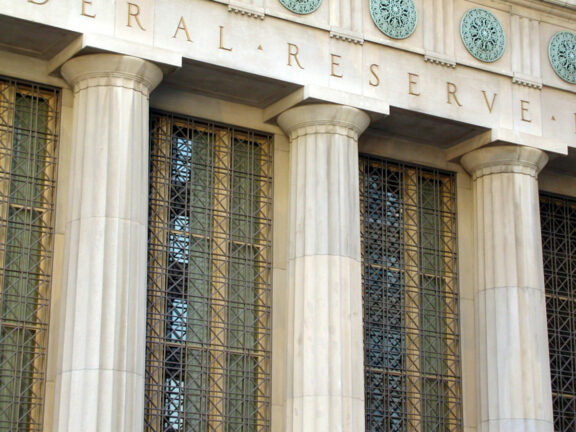Whether you’re focused on saving, paying off debt or both, the latest Federal Reserve rate announcement may impact your strategy.

On Wednesday, the Federal Reserve announced that they would be lowering the federal funds rate from 2.25% to 2.0%.[1] That quarter-point drop in interest rates may seem small, but it can have a big impact on your finances. This is the first time that the Fed has lowered the federal funds rate since the Great Recession. But what does it really mean for consumers when the Fed lowers interest rate?
The federal funds rate affect rates on saving and on debt
Every consumer’s interest rate is based on the federal funds rate. Banks, lenders and even credit card companies determine the interest rates that they offer based on what the Federal Reserve does. Even though the interest rates you pay on debt depend on personal factors like your credit score, they’re also tied to the federal funds rate.
The Federal Reserve raises interest rates when the economy is strong
During a strong economy, like what we’ve enjoyed for the past few years, the Federal Reserve will raise interest rates to combat inflation. Their goal is to keep the economy stable, so the price of goods doesn’t become too high. Consumer interest rates also rise accordingly on any financial product that has an interest rate applied. This is both good and bad for consumers.
A higher federal funds rate means:
- The APR applied to your debt is higher, so your debts accrue interest faster and effectively cost more. Borrowing is more costly when interest rates are higher.
- On the other hand, interest rates (APY) on savings products are higher, too. This means your savings can grow faster. Savers are rewarded when interest rates are high.
Then the Fed lowers interest rates when the economy is weak
If the economy is weak, the Fed will lower interest rates to encourage businesses and consumers to buy and borrow. The idea is that lower interest rates will encourage people to take out new loans, refinance existing debt and spur the economy.
A lower federal funds rate means:
- It’s cheaper to borrow and carry debt. Interest rates are lower, which makes it a good time to take out new loans and refinance existing debt.
- On the other hand, savings rates drop, too. You can’t get the great interest rates on savings tools that you can during a strong economy. And if you have variable rates on products like a Money Market Accounts (MMAs) then the growth will slow down.
What to do with your finances when the fed lowers interest rates
“If you’re working to pay off debt, it’s good news when the Fed lowers interest rates,” explains Gary Herman, President of Consolidated Credit. “Most credit cards have variable interest rates, so changes in the federal funds rate affect the APR on your accounts. A lower federal funds rate might also indicate that it’s a good time to refinance loans, such as your mortgage?”
Keep an eye out for rate announcements from your credit card companies
Herman advises that you should be on the lookout for any notices of decreased APR on your credit card accounts. Credit card APR is currently at record highs, with average APR at 17.80%. At that high of a rate, half of every minimum payment you make on a credit card goes to cover accrued monthly interest charges.
If you owe $5,000 at 18% APR, your minimum payment is typically $150 with most credit cards. But $75 of that payment covers interest charges. So only half of your payment actually goes to pay down your balance.
“If your credit card companies don’t automatically lower your rates over the next few months, call them,” Herman encourages. “Tell the customer service representative that you want to discuss lowering your interest rate. You may be able to lower the APR on your accounts, particularly if you’ve been a good customer that always pays your bills on time.”
Lock in higher savings rates now

Currently, there are traditional savings accounts that offer interest rates up to 2%. That’s extremely good for a basic savings account, given that many accounts have rates of less than 0.1%.
The Chairman of the Federal Reserve Jerome Powell has hinted that this may not be the last time the Fed lowers interest rates this year. There may be another quarter-point drop in September or later in the year.
“Contact your bank or credit union now to see what kind of interest rates they offer on savings accounts,” Herman says. “You may be able to lock in a higher rate now, so you can enjoy better growth on your savings.”
Herman warns to check the terms of the savings account carefully before you sign up. The accounts that offer the best rates often have special requirements, such as a minimum deposit to open the account and a minimum balance you must maintain.
“It’s not uncommon for a bank or credit union to require a minimum balance of $1,000 on savings accounts with better rates of growth,” Herman continues. “Just make sure you can meet the terms to avoid penalties. But if you can, take advantage of savings tools that offer better growth while they’re available.”
Wait to refinance because lower rates may be on the way
Given that Powell hinted at the Federal Reserve lowering rates again, Herman says you may want to hold off on refinancing for the time being. If you can afford to delay taking out new loans, such as a mortgage or auto loan, for a few months, you may want to do that as well.
“Refinancing usually comes with additional fees,” Herman explains. “For instance, if you refinance your mortgage, you usually need to pay another round of closing costs. So, you don’t want to refinance frequently, but you still want to take advantage of lower rates to reduce total interest charges. Since the Fed has hinted at another decrease already, wait for a few months if you can. If the federal funds rate drops again, then it’s definitely a good time to refinance and take out new loans.”
